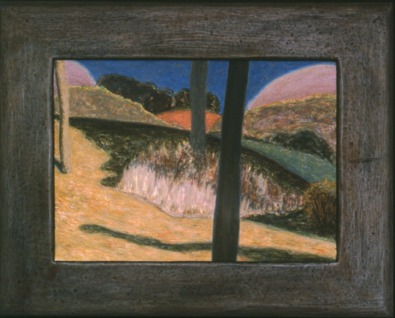
|
||
|
Portland art blog + news + exhibition reviews + galleries + contemporary northwest art
|
||
Nick Blosser at PDX Hilly Landscape 2004 Egg tempera on wood There is something about egg tempera paint. It's in the colors, certainly, but in the texture, too. Though it has a flat, matte finish, unlike oil, which has a subtle glisten, tempera glows. Its rich luminosity heightens the surfaces it covers like candlelight in a darkened room. Then, there's the history of it. When peered at closely, even a modern work in tempera takes on a medieval quality. Nick Blosser, in his current show at PDX Contemporary Art Gallery, has used this quality to fine advantage. The small landscapes succeed in natural or artificial light because of the inherent calm fluorescence of the paint. Blosser adds the paint in thin layers, or builds it up for greater depth. The leaves on his trees, consisting of small brush strokes, possess a mass and volume that is unexpected, considering the lack of impasto. Blosser says that he works "toward retaining strong abstract relationships within each painting [while keeping] in place something authentic about the places [he] paints." The result for the viewer is familiarity with observed locations, but more clearly delineated forms and colors than are seen in nature. Most of his scenes are of cultivated or reclaimed landscape. Fruit trees in blossom, long shadows across a field. In Hayrolls Under a Tree, one gets an impression of domesticity and hard farm labor. Many of his locales seem like great spots to picnic. It's the edge of abstraction that makes them innovative, rather than postcard pretty. One of the paintings, Trees on a Hill, is as near abstract as Serusier's The Talisman. His delicate use of color ends the similarity. Kudos to Blosser for making his own frames, an ability and inclination I would like to see more artists aspire to. Blosser's frames, of carved, painted wood, so perfectly match his paintings in mood and visual appeal, one cannot imagine the paintings presented in any other fashion. The effort is appreciated. Posted by Andie DeLuca on July 16, 2005 at 11:48 | Comments (2) Comments
Fluorescent pigment has very specific qualities which separate it from other pigment applications which appear to glow. Fluorescent pigment actually does glow! Curator Muriel Bartol described it in the press release for "Fluorescence: brighter than white." "When light shines on fluorescent paint the molecules convert high energy ultraviolet light into electromagnetic waves within the visible spectrum. Because fluorescence transforms invisible light into visible light-waves it appears to shine from within." Sorry, I had to. But I do love that phrase, "calm fluorescence". Yum. Posted by: MOR You are right. However, on the one hand: picky, picky, picky. On the other hand, I need a better thesaurus. Posted by: andie Post a comment Thanks for signing in, . Now you can comment. (sign out)
(If you haven't left a comment here before, you may need to be approved by
the site owner before your comment will appear. Until then, it won't appear
on the entry. Thanks for waiting.)
|
| s p o n s o r s |
 |
 |
 |
 |
 |
 |
 |
 |
 |
 |
 |
 |
 |
 |

|
Site Design: Jennifer Armbrust | • | Site Development: Philippe Blanc & Katherine Bovee | |



![[TypeKey Profile Page]](http://www.portlandart.net/nav-commenters.gif)